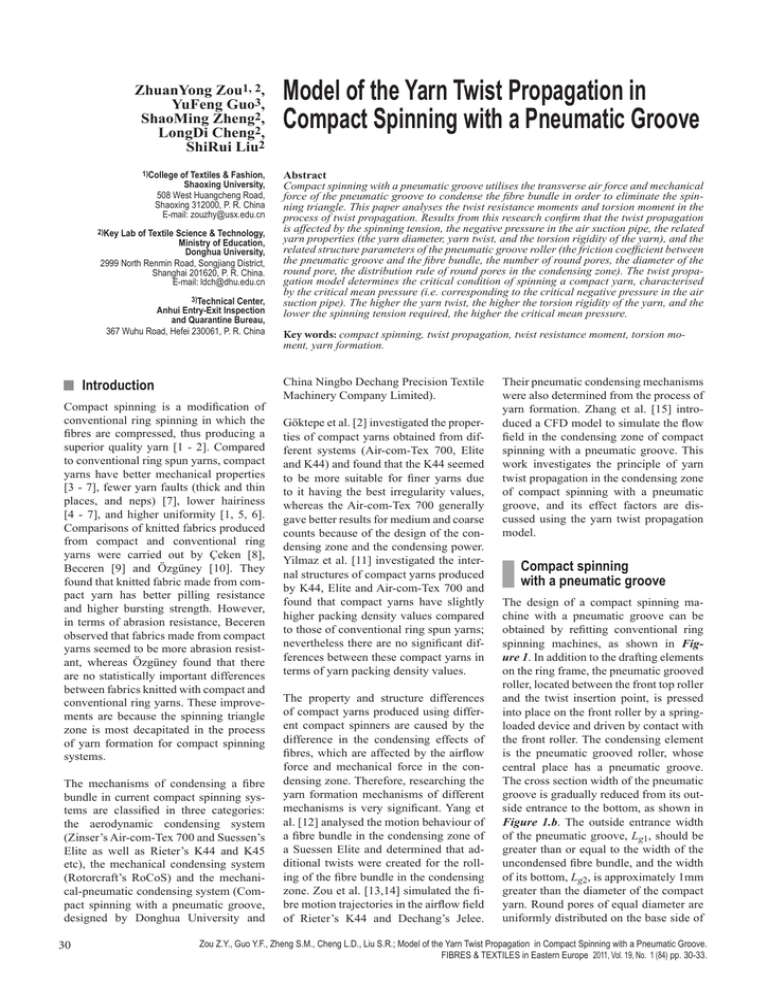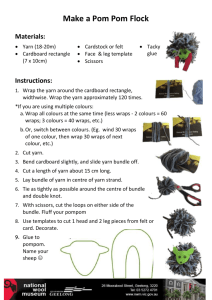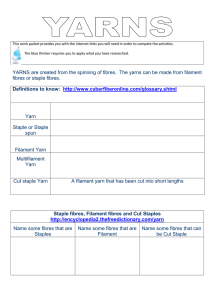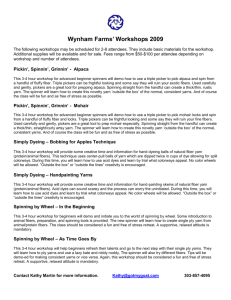Model of the Yarn Twist Propagation in ZhuanYong Zou ,
advertisement

ZhuanYong Zou1, 2, YuFeng Guo3, ShaoMing Zheng2, LongDi Cheng2, ShiRui Liu2 1)College of Textiles & Fashion, Shaoxing University, 508 West Huangcheng Road, Shaoxing 312000, P. R. China E-mail: zouzhy@usx.edu.cn 2)Key Lab of Textile Science & Technology, Ministry of Education, Donghua University, 2999 North Renmin Road, Songjiang District, Shanghai 201620, P. R. China. E-mail: ldch@dhu.edu.cn 3)Technical Center, Anhui Entry-Exit Inspection and Quarantine Bureau, 367 Wuhu Road, Hefei 230061, P. R. China n Introduction Compact spinning is a modification of conventional ring spinning in which the fibres are compressed, thus producing a superior quality yarn [1 - 2]. Compared to conventional ring spun yarns, compact yarns have better mechanical properties [3 - 7], fewer yarn faults (thick and thin places, and neps) [7], lower hairiness [4 - 7], and higher uniformity [1, 5, 6]. Comparisons of knitted fabrics produced from compact and conventional ring yarns were carried out by Çeken [8], Beceren [9] and Özgüney [10]. They found that knitted fabric made from compact yarn has better pilling resistance and higher bursting strength. However, in terms of abrasion resistance, Beceren observed that fabrics made from compact yarns seemed to be more abrasion resistant, whereas Özgüney found that there are no statistically important differences between fabrics knitted with compact and conventional ring yarns. These improvements are because the spinning triangle zone is most decapitated in the process of yarn formation for compact spinning systems. The mechanisms of condensing a fibre bundle in current compact spinning systems are classified in three categories: the aerodynamic condensing system (Zinser’s Air-com-Tex 700 and Suessen’s Elite as well as Rieter’s K44 and K45 etc), the mechanical condensing system (Rotorcraft’s RoCoS) and the mechanical-pneumatic condensing system (Compact spinning with a pneumatic groove, designed by Donghua University and 30 Model of the Yarn Twist Propagation in Compact Spinning with a Pneumatic Groove Abstract Compact spinning with a pneumatic groove utilises the transverse air force and mechanical force of the pneumatic groove to condense the fibre bundle in order to eliminate the spinning triangle. This paper analyses the twist resistance moments and torsion moment in the process of twist propagation. Results from this research confirm that the twist propagation is affected by the spinning tension, the negative pressure in the air suction pipe, the related yarn properties (the yarn diameter, yarn twist, and the torsion rigidity of the yarn), and the related structure parameters of the pneumatic groove roller (the friction coefficient between the pneumatic groove and the fibre bundle, the number of round pores, the diameter of the round pore, the distribution rule of round pores in the condensing zone). The twist propagation model determines the critical condition of spinning a compact yarn, characterised by the critical mean pressure (i.e. corresponding to the critical negative pressure in the air suction pipe). The higher the yarn twist, the higher the torsion rigidity of the yarn, and the lower the spinning tension required, the higher the critical mean pressure. Key words: compact spinning, twist propagation, twist resistance moment, torsion moment, yarn formation. China Ningbo Dechang Precision Textile Machinery Company Limited). Göktepe et al. [2] investigated the properties of compact yarns obtained from different systems (Air-com-Tex 700, Elite and K44) and found that the K44 seemed to be more suitable for finer yarns due to it having the best irregularity values, whereas the Air-com-Tex 700 generally gave better results for medium and coarse counts because of the design of the condensing zone and the condensing power. Yilmaz et al. [11] investigated the internal structures of compact yarns produced by K44, Elite and Air-com-Tex 700 and found that compact yarns have slightly higher packing density values compared to those of conventional ring spun yarns; nevertheless there are no significant differences between these compact yarns in terms of yarn packing density values. The property and structure differences of compact yarns produced using different compact spinners are caused by the difference in the condensing effects of fibres, which are affected by the airflow force and mechanical force in the condensing zone. Therefore, researching the yarn formation mechanisms of different mechanisms is very significant. Yang et al. [12] analysed the motion behaviour of a fibre bundle in the condensing zone of a Suessen Elite and determined that additional twists were created for the rolling of the fibre bundle in the condensing zone. Zou et al. [13,14] simulated the fibre motion trajectories in the airflow field of Rieter’s K44 and Dechang’s Jelee. Their pneumatic condensing mechanisms were also determined from the process of yarn formation. Zhang et al. [15] introduced a CFD model to simulate the flow field in the condensing zone of compact spinning with a pneumatic groove. This work investigates the principle of yarn twist propagation in the condensing zone of compact spinning with a pneumatic groove, and its effect factors are discussed using the yarn twist propagation model. Compact spinning with a pneumatic groove The design of a compact spinning machine with a pneumatic groove can be obtained by refitting conventional ring spinning machines, as shown in Figure 1. In addition to the drafting elements on the ring frame, the pneumatic grooved roller, located between the front top roller and the twist insertion point, is pressed into place on the front roller by a springloaded device and driven by contact with the front roller. The condensing element is the pneumatic grooved roller, whose central place has a pneumatic groove. The cross section width of the pneumatic groove is gradually reduced from its outside entrance to the bottom, as shown in Figure 1.b. The outside entrance width of the pneumatic groove, Lg1, should be greater than or equal to the width of the uncondensed fibre bundle, and the width of its bottom, Lg2, is approximately 1mm greater than the diameter of the compact yarn. Round pores of equal diameter are uniformly distributed on the base side of Zou Z.Y., Guo Y.F., Zheng S.M., Cheng L.D., Liu S.R.; Model of the Yarn Twist Propagation in Compact Spinning with a Pneumatic Groove. FIBRES & TEXTILES in Eastern Europe 2011, Vol. 19, No. 1 (84) pp. 30-33. Figure 1. Compact system with pneumatic groove; a) Vertical view of the condensing zone, b) Cross section of the pneumatic groove. the pneumatic groove, their diameters being equal to the bottom width of the pneumatic groove. Round pores located in the condensing zone (minor arc P11E) are connected with the suction mouth of the stationary inner drum, which is placed inside the pneumatic grooved roller, but other round pores are separated by the stationary inner drum, shown in Figure 2. The number of round pores located in the condensing zone (minor arc P11E) is n, where variable i signifies the i-th round pore. The air current through round pores of the condensing zone distributed along minor arc P11E flows to Figure 2. Pneumatic condensing zone of a fibre bundle in the compact system. the centre of the pneumatic grooved roller due to the negative pressure effect in the air suction pipe. The process of compact fibre bundle formation is also presented in Figure 2. The fibre bundle delivered from the nip point between the front top roller and front roller is preliminarily condensed by the transverse airflow force and is then pulled to the bottom of the pneumatic groove along line AC. The fibre bundle in the BC region is synchronously converged by the pneumatic force and mechanical force caused by the reduction of the cross section of the pneumatic groove. The condensed fibre bundle is twisted into a yarn along minor arc DC and then separated at point D. n Twist propagation analysis Figure 3. Distribution rule of round pores along minor arc DE. FIBRES & TEXTILES in Eastern Europe 2011, Vol. 19, No. 1 (84) When the fibre bundle has just entered into the pneumatic groove, it should be condensed by the transverse airflow force produced by negative pressure in the air suction pipe, which demands that there is one or more round pores over the point of contact C. Furthermore, the delivery route of the fibre bundle entering the pneumatic groove should not be interfered by a too large airflow force over the point of contact C. Hence the number of round pores over the point of contact C in this compact spinning system is designed to be one. The distribution rule of round pores along minor arc DE is shown in Figure 3. The number n of round pores along minor arc P11E, can be calculated by γ −α (1) n= +1 α +β where γ is the radian of minor arc P11E, α the radian of minor arc Pi1Pi2, and β is the radian of minor arc Pi2P(i+1)1 between two adjacent round pores. The frictions acting on the fibre bundle delivered along minor arc DC can be divided into two parts: the friction F1 produced by the spinning tension T, and the friction F2 produced by the radial airflow force Nc at the round pore entrance. When the twist propagates from point D to point C, the twist propagation is resisted by friction moments produced by the spinning tension and radial airflow force. Twist resistance moment Mt produced by the spinning tension When the twist propagates from point D to point C, the spinning tension gradually decreases. The change in spinning tension during twist propagation through the infinitesimal radian dθ is shown in Figure 4 (see page 32). The infinitesimal radial pressure, dNt, produced by the spinning tension during twist propagation through radian dθ can be expressed by 31 F1 is the total frictional force along the opposite direction of yarn rotation from point D to point C for the action of the radial spinning tension, n −1 ∑ Nti is i =0 Figure 4. Change of spinning tension in the infinitesimal radian. dθ dθ dN t = T sin + (T − dT ) sin( ) 2 2 (2) dθ dθ dθ ≈ Tdθ ≈T +T − dT 2 2 2 ti Substituting Equations (3) ~ (5) into Equation (6), Mt can be derived from d y µTD 2 n-2 (η1 + β ∑ e i =1 − µ (η1 + (i −1) β ) + η2e (7) TPij (i=1… n-1; j=1,2) standsdfor the spin- n-2 − µ (η + (i −1) β ) y µTD − µ η + n − 2 β ( ( ) ) (η1 +atβ ∑ e 1 + η2e 1 ) t =fibre bundle ning tension acting onM the 2 i =1 point Pij, where TPi1 is equal to TPi2 due to there being no tension attenuation. It Twist resistance moment Ma is assumed that TD represents the spinning tension acting on the fibre bundle produced by the radial airflow at point D. Therefore, based on Equaforce tion (2), the radial pressure, Nt0, along The radial airflow force at the entrance minor arc DP11 can be calculated by of round pores along minor arc CD is Equation (3). produced by negative pressure in the air η1 (3) suction pipe. It can be assumed that Pi N t 0 = ∫ TD dθ = TDη1 0 (i = 1…n - 1) stands for the mean preswhere η1 is the radian of minor arc DP11. sure value at the inlet of round pore i, which can be obtained by constructing Analogously, according to Euler’s fora computational fluid dynamic model to mula, the radial pressure, Nti (i=1…n-2), simulate the flow field in the condensing along minor arc Pi2P(i+1)1 can be written zone. Furthermore, it is assumed that the as follows: width of the condensed fibre bundle is β N ti = ∫ TPi 2 dθ (i = 1…n - 2) (4a) approximately equal to the diameter of 0 the compact yarn. Therefore, the radial airflow force acting on the fibre bundle, − µη1 TPi 2 = TPi1 = TD e (i=1) and Nc , can be obtained by (4b) n −1 − µβ TPi 2 = TPi1 = TP(i-1) 2 e (i=2…n-2) (8) N c = d y d p ∑ Pi i=1 where μ is the friction coefficient between the pneumatic groove and fibre bundle. Then the radial pressure, Nt(n-1), along minor arc P(n-1)2C can be expressed by η2 η2 0 0 N t (n-1) = ∫ TP(n-1) 2 dθ = ∫ TP(n-2) 2 e − µβ dθ (5) where η2 is the radian of minor arc P(n-1)2C. As a result, the twist resistance moment, Mt , produced by spinning tension can be determined in the form Mt = dy 2 F1 = dyµ 2 n −1 ∑N i =0 where: dy is the diameter of the yarn, 32 ti (6) Ma = µ d y 2d p 2 the total radial pressure from point D to point C, which not only prevents fibre bundle delivery from point C to point D but also prevents fibre bundle rotation on the yarn axis caused by the twist moment action on the yarn. Mt = Substituting Equation (8) into Equation (9), Ma can be derived from where dp is the diameter of a round pore. n −1 ∑P i=1 i (10) Torsion moment M produced for twist insertion When unidirectional twist is inserted into the yarn, the yarn will be acted on by the torsion moment M. According to elastic theory, the torsion moment, M, can be given by Equation (11) [16]. Ny M = T )G y δ y − µ (η1 + ( n − 2 ) β ) y 2 π2 −10 Ty G y d y 4 = ×10 = 16 (11) = 2π Ty C y where Ty is the yarn twist, Gy the shear modulus of the yarn, Ny the linear density of the yarn, δy the yarn density, and Cy is the torsion rigidity of the yarn. n Analysis and discussion Before the fibre bundle is completely condensed by the transverse airflow force and mechanical force of the pneumatic groove (i.e. before the fibre bundle enters into the bottom of the pneumatic groove), the fibre bundle should not be twisted, otherwise a spinning triangle will be created, resulting in more yarn hairiness. Therefore, this demands that the amount of twist resistance moments be greater than or equal to the amount of torsion moments produced for twist insertion, i.e., (12) Mt + Ma ≥ M Substituting Equations (7), (10) and (11) into Equation (12), inequality (12) can be modified as follows: Thus the twist resistance moment, Ma, n−2 µd y TD η1 + β ∑ e − µ (η1 +(i −1)β ) ++η 2 e − µ (η1 +(n − 2 )β ) produced by the radial airflow force can i =1 be represented by n−2 dy d y µ Nc (13) µd y TD η1 +(9)β ∑ e − µ (η1 +(i −1)β )++η 2 e − µ (η1 +(n − 2 )β ) + Ma = F2 = i =1 2 2 where: F2 is the total frictional force along the opposite direction of yarn rotation from point D to point C for the action of the radial airflow force, Nc - the total radial airflow force acting on the fibre bundle at all round pores from point D to point C, not only prevents fibre bundle delivery from point C to point D but also prevents fibre bundle rotation on the yarn axis caused by the twist moment action on the yarn. n −1 + µd y 2 d p ∑ Pi ≥ 4πT y C y i =1 Inequality (13), which is used for judging whether the compact yarn is successfully spun or not, can be satisfied by adjusting the following parameters: the spinning tension TD, the yarn diameter dy, the related structure parameters of the pneumatic grooved roller (the friction coefficient between the pneumatic groove and the fibre bundle μ, the number of round FIBRES & TEXTILES in Eastern Europe 2011, Vol. 19, No. 1 (84) pores n, the diameter of the round pore dp, the radian of adjacent round pores β, the radian of the minor arc between point D and point P11 η1, the radian of the minor arc between point P(n-1)2 and point C, η2), and the negative pressure at the inlet of round pore i, Pi, controlled by the negative pressure in the air suction pipe, the yarn twist Ty, and the torsion rigidity of the yarn Cy. When the twist just propagates to point C, the twist resistance moments should be equal to the torsion moment produced for twist insertion, i.e., n−2 4πT y C y − µd y TD η1 + β ∑ e − µ (η1 +(i −1)β ) +η 2 e − µ (η1 +(n − 2 )β ) i =1 P= 2 (n − 1) µd y d p Equation 15. and cotton yarn. In addition, the critical mean pressure, P, is also affected by the spinning tension, TD, which is higher at low spinning tensions. When the critical mean pressure, P, is n−2 n − 2 )β ) µd y TD η1 + β ∑ e − µ (η1 +(i −1)β ) +η 2 e − µ (η1 +(higher, the critical negative pressure in i =1 suction pipe is also higher. High the air (14) n − 1 n−2 negative pressure in the air suction pipe 2 β ∑ e − µ (η1 +(i −1)β )++η 2 e − µ (η1 +(n − 2 )β ) + µd y d p ∑ Pi = can strengthen the transverse airflow i =1 i =1 force in the condensing zone, which can = 4πT y C y allow floating fibres to approach the centre of the fibre bundle in order to guarAccording to Equation (14), we can ob- antee all fibres enter into the pneumatic tain the critical mean pressure Pi at the groove. However, high negative pressure inlet of any round pore along minor arc in the air suction pipe will increase the DC to ensure twist propagation to point cost of compact spinning. In this case, C. It can be assumed that the critical after the parameters of a designed yarn mean pressure, Pi, for any round pore are fixed, the optimal negative pressure along minor arc DC is approximately in the air suction pipe can be determined equal to the critical mean pressure, P (i.e. by adjusting the spinning tension, T , D corresponding to the critical negative and the related structure parameters of pressure in the air suction pipe), in which the pneumatic grooved roller. case Equation (14) can be modified as Equation (15). Based on Equation (15), the critical mean pressure, P, is a function of the following parameters: the spinning condition (the spinning tension TD), the related yarn properties (the yarn diameter dy, the yarn twist Ty, the torsion rigidity of the yarn Cy), and the related structure parameters of the pneumatic grooved roller (the friction coefficient μ, the number of round pores n, the diameter of the round pore dp, the radians β, η1 & η2). Once the related structure parameters of the pneumatic grooved roller of a compact spinning system are fixed, a higher twist, Ty, requires a higher critical mean pressure, P (i.e. corresponding to the higher critical negative pressure in the air suction pipe). The critical mean pressure, P, increases with the augmentation of the torsion rigidity of the yarn, Cy. For a yarn with the same twist produced by the same spinning system, the torsion rigidity of the yarn, Cy, is affected by the fibre types. The torsion rigidity of yarn made of bast fibres is the biggest, followed by woollen yarn and cotton yarn. Therefore, when the above yarns are spun, the critical mean pressure, P, is highest for yarn of bast fibres, followed by woollen yarn FIBRES & TEXTILES in Eastern Europe 2011, Vol. 19, No. 1 (84) (15) n Conclusions In this study, the twist resistance moments produced by the spinning tension and radial airflow force in compact spinning with a pneumatic groove are analysed. The torsion moment produced for twist insertion is also presented. The current work has constructed a model of the twist propagation in the process of yarn formation. The model is used to establish the critical mean pressure for spinning a compact yarn. The critical mean pressure is a function of the spinning tension, the related yarn properties, and the related structure parameters of the pneumatic grooved roller. A high yarn twist, high torsion rigidity of the yarn and low spinning tension require a high critical mean pressure (i.e. corresponding to the high negative pressure in the air suction pipe). Although the high negative pressure in the air suction pipe can enhance the condensing effect of the fibre bundle, the added cost of compact spinning at a high negative pressure should also be taken into consideration. The optimal negative pressure for the air suction pipe can be determined by Equa- tion (15). Further experiments will be carried out for a more advanced investigation. Acknowledgments n This research was supported by the Scientific Research Foundation of Shaoxing University, under grant NO. 20105010. n We are grateful to Prof. Zhi Hong Hua and Prof. Xiu Ye Yu of Donghua University for their help with some of the mathematics and language in this work. References 1. Çelik P., Kadoğlu H.; Fibres Text. East. Eur., Vol. 12(4) 2004, pp. 27-31. 2. Göktepe F., Yilmaz D., Göktepe Ö.; Textile Res. J., Vol. 76(3) 2006, pp. 226-234. 3. Basal G., Oxenham W.; Textile Res. J., Vol. 76(7) 2006, pp. 565-575. 4. Cheng K.P.S., Yu C.; Textile Res. J., Vol. 73(4) 2003, pp. 345-349. 5. Nikolić M., Stjepanovič Z., Lesjak F., Štritof A.; Fibres Text. East. Eur., Vol. 11(4) 2003, pp. 30-35. 6. Czekalski J., Cyniak D., Jackowski T., Sieradzki K.; Fibres Text. East. Eur., Vol. 15(3) 2007, pp. 38-44. 7. Das A., Kothari V. K., Sadachar A.; Fibres and polymers, Vol. 8(1) 2007, pp. 111-115. 8. Çeken F., Göktepe F.; Fibres Text. East. Eur., Vol. 13(1) 2005, pp. 47-50. 9. Beceren Y., Nergis B. U.; Textile Res. J., Vol. 78(4) 2008, pp. 297-303. 10. Özgüney A. T., Kretzschmar S. D., Özçelik G., Özerdem A.; Textile Res. J., Vol. 78(2) 2008, pp. 138-147. 11. Yilmaz D., Göktepe F., Göktepe Ö., Kremenakova D.; Textile Res. J., Vol. 77(9) 2007, pp. 661-667. 12. Yang X., Wang J., Yang J. P.; J. Donghua Uni. (Eng. Ed.), Vol. 23(1) 2006, pp. 144-147. 13. Zhang X. C., Zou Z. Y., Cheng L. D.; Textile Research Journal, Vol. 80(1) 2010, pp. 84-92. 14. Zou Z. Y., Cheng L. D., Hua Z. H.; Textile Research Journal, Vol. 80(5) 2010, pp. 395-402. 15. Zou Z. Y., Zhu Y. D., Hua Z. H., Wang Y., Cheng L. D.; Textile Research Journal, Vol. 80(8) 2010, pp. 712-719. 16. Yu W. D., “Science of Textile Material”, Textile Industry Publishing House, Beijing, China, 2006. Received 08.01.2010 Reviewed 18.03.2010 33




